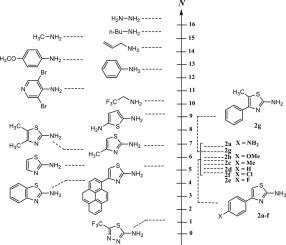Journal of Saudi Chemical Society ( IF 5.6 ) Pub Date : 2020-08-26 , DOI: 10.1016/j.jscs.2020.08.004 Reem A. Alenzi , Nizar El Guesmi , Mohamed R. Shaaban , Basim H. Asghar , Thoraya A. Farghaly

|
A kinetic study of the reactions of potentially bioactive 2-amino-4-arylthiazoles with highly reactive 4,6-dinitrobenzofuroxan (DNBF) is reported herein in acetonitrile solution. The complexation reaction was followed by recording the UV–vis spectra with time at λmax = 482 nm. Electronic effects of substituents influencing the rate of reaction have been studied using structure-reactivity relationships. It is shown that the Hammett plot relative to the reaction of DNBF with 2-amino-4-(4-chlorophenyl)thiazole exhibit positive deviation from the log k1 versus σ correlation, while it showed excellent linear correlation in terms of Yukawa–Tsuno equation. It has be noticed that the nonlinear Hammett plot observed for 2-amino-4-(4-chlorophenyl) thiazole is not attributed to a change in rate-determining step but is due to nature of electronic effect of substituent caused by the resonance of stabilization of substrates. The second-order rate constant (k1) relating to the bond C–C and C-N forming step of the complexation processes of DNBF with 4-substituted-aminothiazoles and 2-amino-5-methyl-4-phenylthiazole, respectively, is fit into the linear relationship log k = sN (N + E), thereby permitting the assessment of the nucleophilicity parameter (N) of the 2-amino-4-arylthiazoles of the range (4.90 < N < 6.85). 2-amino-4-arylthiazoles is subsequently ranked by positioning its reactivity on the general nucleophilicity scale developed recently by Mayr and coworkers (2003) leading an interesting and a direct comparison over a large domain of π-, σ -, and n-nucleophiles. The global electrophilicity/nucleophilicity reactivity indexes of the 2-amino-4-arylthiazoles have been investigated by means of a density functional theory (DFT) method. .
中文翻译:

通过与4,6-二硝基苯并呋喃的偶合评估2-氨基-4-芳基噻唑的亲核特性:基于结构反应性关系的实验和理论方法
本文报道了在乙腈溶液中可能具有生物活性的2-氨基-4-芳基噻唑与高反应性4,6-二硝基苯并呋喃(DNBF)反应的动力学研究。络合反应后,随时间记录在λmax = 482 nm处的UV-vis光谱。已经使用结构反应性关系研究了取代基影响反应速率的电子效应。结果表明,相对于DNBF与2-氨基-4-(4-氯苯基)噻唑的反应,Hammett图相对于log k 1表现出正偏差。与σ相关,而在Yukawa–Tsuno方程方面显示出极好的线性相关。已经注意到,对于2-氨基-4-(4-氯苯基)噻唑观察到的非线性哈米特图不归因于速率确定步骤的变化,而是归因于由稳定共振引起的取代基的电子效应的性质。基板。拟合分别与DNBF与4-取代-氨基噻唑和2-氨基-5-甲基-4-苯基噻唑络合过程的键C–C和CN形成步骤有关的二级速率常数(k 1)取线性关系log k = s N(N + E),从而可以评估亲核参数(Ñ)的范围内(4.90 <的2-氨基-4- arylthiazoles的 Ñ <6.85)。随后将2-氨基-4-芳基噻唑的反应性定位在Mayr和他的同事(2003年)最近开发的一般亲核性等级上,从而在π-,σ-和n-亲核体的大范围内进行了有趣而直接的比较。。通过密度泛函理论(DFT)方法研究了2-氨基-4-芳基噻唑的整体亲电/亲核反应性指数。。



























 京公网安备 11010802027423号
京公网安备 11010802027423号